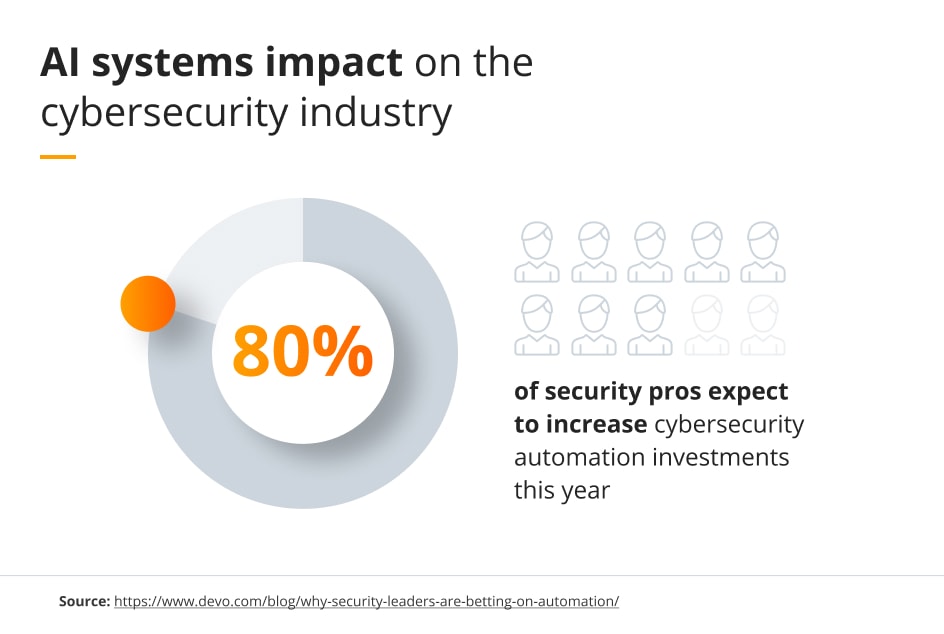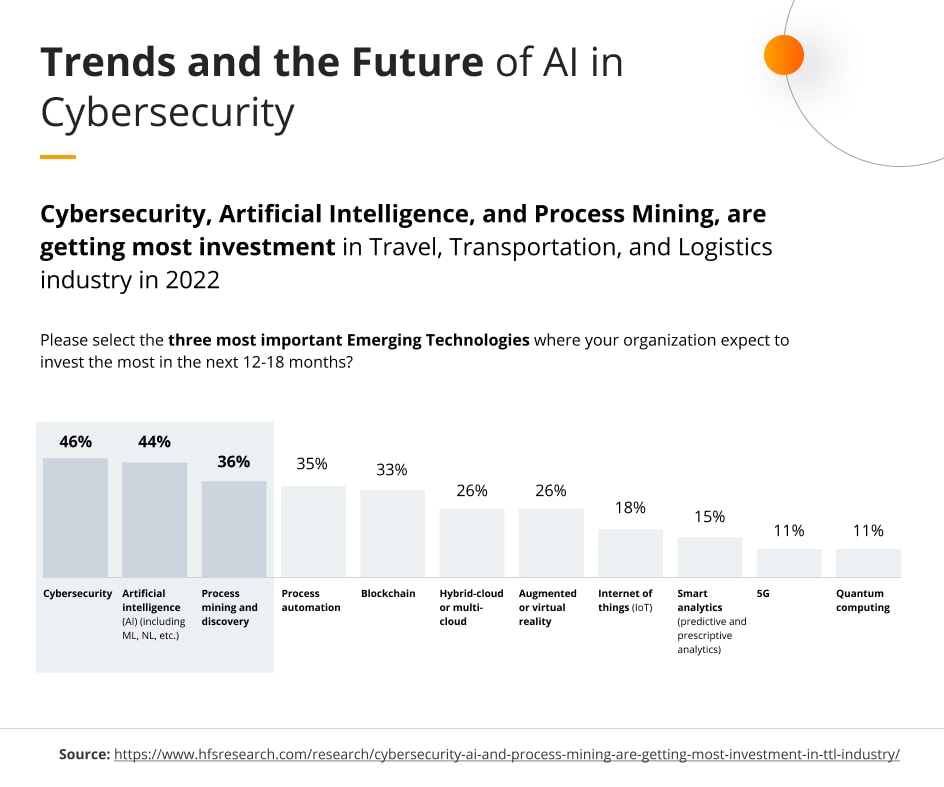
The future of AI in cybersecurity
To protect themselves against digital attacks, companies are increasingly using artificial intelligence (AI) and machine learning to boost their cybersecurity. Threats are only increasing, and companies need to combine traditional security methods with new AI and machine learning development to protect them from devastating losses.
Have you ever received emails from companies apologizing for a hacking incident and recommending you change your password? Have you ever seen advertisements or buttons on websites promising you free vacations and money? Have you ever received emails threatening you for money after someone supposedly got hold of your sensitive information?
Those data breach, virus, and social engineering incidents are all examples of cybersecurity threats. According to IBM, cybersecurity can be defined as “the practice of protecting critical systems and sensitive information from digital attacks.” These digital attacks often aim to access sensitive data, extort money from organizations, or disrupt normal business processes.
To protect themselves against digital attacks, companies are increasingly using artificial intelligence (AI) and machine learning to boost their cybersecurity. Threats are only increasing, and companies need to combine traditional security methods with new AI and machine learning development to protect them from devastating losses.
Traditional cybersecurity methods
Cybersecurity can be broken down into critical infrastructure security, application security, network security, cloud security, and Internet of Things (IoT) security. To protect these, cybersecurity professionals should create a plan that protects these types of security by addressing the three active components of them.
Protecting people
First, the personnel involved need to be trained. Many threats involve manipulating people into compromising security by asking for sensitive information or impersonating someone else to collect data they shouldn’t have. Non-IT personnel are often more susceptible to cyber-attacks because of their lack of cybersecurity expertise, and they often have information or access to systems that can compromise it. To prevent this, all employees should undergo security awareness training and learn basic cybersecurity best practices.
While artificial intelligence technology may be able to detect threats targeting personnel and warn them, such as marking suspicious emails, social engineering experts are skilled in manipulating people into giving information. Systems are only as strong as their weakest part, and human error is often a target of exploitation.
Protecting processes
Second, cybersecurity plans should include appropriate processes, including adopting cybersecurity frameworks, company policies, and consistent documentation of any changes. These processes are often developed through research, industry professionals, and the government working together and are publicly available for everyone to use.
They are important in guiding the implementation of artificial intelligence into systems, as they guide where artificial intelligence and machine learning can be used and make sure that it is compliant with industry standards. Additionally, if the AI happens to fail, these documents guide on steps to recover systems.
Protecting technology
Lastly, companies and individuals need to protect their technology from threats, as well as implement technology that will prevent attacks. Implementing technology like DNS filtering, malware protection, antivirus, and more will protect your computers, smart devices, networks, and other technologies.
While traditional methods can detect known threats, new and increasingly sophisticated threats can evade detection. This makes technology one of the biggest parts of cybersecurity that artificial intelligence is revolutionizing, as it can use learning techniques to detect threats it has never faced before.
It is important to note that artificial intelligence cannot replace human expertise, but be a tool for human operators to increase efficiency and free up time for more high-level tasks. As technology advancements see more advanced threats, scientistic will continue to develop AI tools to create AI based cybersecurity solutions to fight cyber threats.
How AI is changing cybersecurity
Artificial intelligence (AI) is transforming the cybersecurity landscape by identifying and analyzing large volumes of data in real-time. This allows for faster and more accurate threat detection, which is crucial in today’s digital landscape during digital transformation, where cyber-attacks are becoming increasingly complex and difficult to detect. Artificial intelligence is shaping the future of cybersecurity by enabling organizations to detect and respond to threats quickly, ultimately improving their overall cybersecurity posture.
Artificial intelligence is being used in cybersecurity to identify and respond to emerging threats. Machine learning algorithms, natural language processing, and context-aware computing are key areas where AI is being applied, according to a report by MarketsandMarkets. By quickly identifying patterns and anomalies in large sets of data, these technologies enable cybersecurity professionals to detect and respond to threats. As a result, artificial intelligence is revolutionizing the cybersecurity industry and helping organizations stay one step ahead of cyber threats.
Automation in cybersecurity
Yet another way artificial intelligence and machine learning are shaping the future of cybersecurity is by leveraging automation technologies. Automating processes such as threat analysis and response can free up security professionals to focus on more complex tasks, enabling a more efficient and effective cybersecurity strategy. This approach not only helps organizations stay ahead of sophisticated cyber threats but also results in cost savings. As AI systems continue to evolve, their impact on the cybersecurity industry will only grow stronger.
Predictive analytics in cybersecurity
Artificial intelligence and machine learning are revolutionizing the field of cybersecurity through predictive analytics. By leveraging historical data and identifying patterns, AI can help security experts anticipate and detect potential cyber threats, allowing them to take proactive measures to prevent attacks. This technology is especially valuable in industries like finance, where cyber-attacks can have significant financial consequences.
Artificial Intelligence cannot replace human judgement
Artificial intelligence is a powerful tool for detecting threats and anomalies, but it is not always effective at removing them. To avoid issues, security teams must continuously train the model using data that includes a strong feedback loop. While AI can assist with tasks such as creating detection criteria and incident response, human judgment is still essential.
The idea that artificial intelligence and machine learning can take the place of human judgment is a misconception. Context, research, and creativity are necessary to anticipate and respond to emerging threats, making tasks such as identifying attack paths and determining detectability distinctly human. AI can support these tasks, but it cannot replace human decision-making.
Artificial intelligence and machine learning are rapidly transforming cybersecurity. With the help of AI, security teams can now detect attacks more accurately and quickly, identify emerging threats, and respond faster to cyber incidents. AI-powered security solutions use machine learning algorithms to process large amounts of data at lightning speed, providing real-time insights and automated responses.
This allows us to make more informed decisions and predict threats before they happen. By leveraging AI, organizations can stay ahead of malicious actors and safeguard their networks. The potential for AI and machine learning to revolutionize the industry is enormous.
Trends and the future of AI in cybersecurity
Hybrid augmented intelligence
Today, most developments in cybersecurity and malware detection are run by either artificial intelligence or human experts, rarely both. One way to advance the future of cybersecurity is to implement hybrid augmented intelligence, in which the efforts of human cybersecurity analysts combine with AI capabilities to produce more effective results against security threats than programs that only utilize human intelligence or AI systems. This can be achieved by having human security specialists aid in the artificial intelligence analytic and machine learning process, so they inadvertently take part in the AI’s decisions.
Generative Adversarial Networks and Machine Learning
Generative Adversarial Networks, or GANs, are products of machine learning that observe existing data and produce new, similar data. Malware authors can use GANs to breach and implant fake data, escaping malware detection. Advances in artificial intelligence in cybersecurity systems will inspire anomaly detection programs that identify patterns such as this malware and eliminate it, reducing the data invasion and manipulation rate.
Adversarial machine learning, an approach in which artificial intelligence systems use knowledge of previous cyberattacks to close any gaps in security, is currently used in cybersecurity to ensure that any breaches in data or privacy will not be repeated, making the task of blocking threats more efficient. However, this does not provide any data security or vulnerability management against zero-day attacks or unknown threats. Further developments in artificial intelligence and data science can allow a more proactive security posture, so it can use threat intelligence to recognize potential points of cyberattack before it happens, breaking the cycle of incident response.
Explainable AI
Explainable AI is a field of study focused primarily on interpreting how an artificial intelligence program works and why certain inputs get certain outputs. This can be used to enhance the use of AI and machine learning in security systems, as understanding the reasons an AI program engages in deep learning and behaves the way it does when protecting data can allow analysts to observe gaps in its security and fix them. Explainable AI is a relatively unresearched field, so further exploration into computer science and AI techniques can unlock many developments in cybersecurity.
Conclusion
Artificial Intelligence is unarguably revolutionizing cybersecurity with its advanced threat detection ability, automation, and predictive analytics. Coupled with new deep learning techniques, a computer system and its connected devices are much safer than it was years ago when the need for cybersecurity was just being discovered.
At the same time, AI and machine learning are being used by malicious users for complex cyber attacks. Thus, it is increasingly important for scientists to continue developing AI-powered tools and organizations to implement AI systems. It may be a large initial investment to change how things have been run, but the payoff of a more secure system is well worth the cost.









